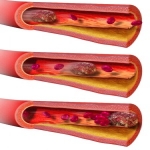A DVT, or deep vein thrombosis is a blood clot formed in a deep vein, typically in the calf or thigh muscle. Several factors may make you at risk for this problem including recent surgery, trauma or fracture; if you are over 60; if you are a smoker; if you are overweight or if you sit for long periods of time. If you develop a clot in a deep vein, you are at risk for complications in your leg as well as other life-threatening problems. A blood clot can break free and travel through your blood to major organs, such as your lungs or heart. If it travels to your lungs, this is called a pulmonary embolism and can be fatal. It is very important to know the signs and symptoms of a DVT. If you do have any of the symptoms, it is important to contact a medical professional immediately.
Signs and Symptoms of DVT
- Swelling in one or both legs
- Pain or tenderness in one or both legs, which may occur only while standing or walking
- Warmth in the skin of the affected leg
- Red or discolored skin in the affected leg
- Visible surface veins
- Leg fatigue
Signs and Symptoms of a Pulmonary Embolism (if you experience these symptoms, it is important to call 911 or go to an emergency room immediately)
- sudden coughing
- sharp chest pain
- rapid breathing or shortness of breath
- severe lightheadedness
The American Academy of Orthopedic Surgeons (AAOS) has developed guidelines on preventing Pulmonary Embolisms. Click here for more information and these guidelines.


